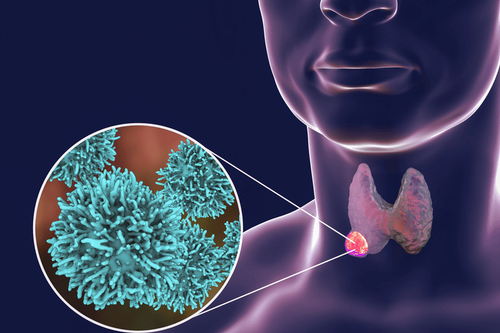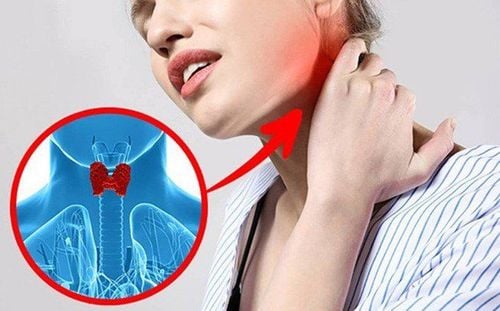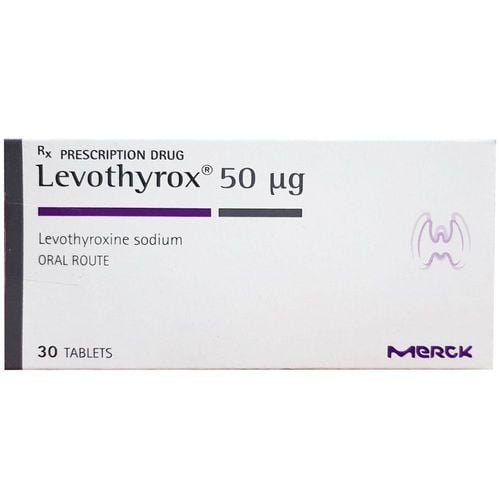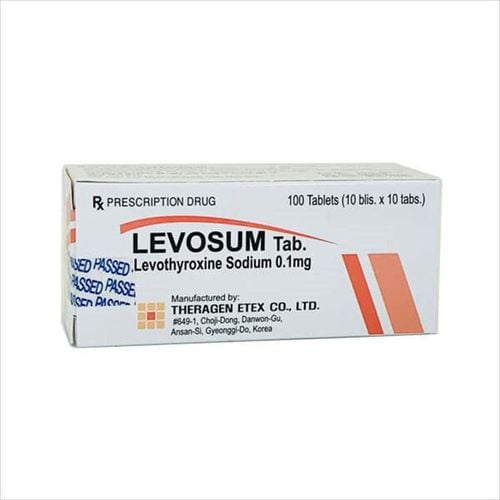This is an automatically translated article.
Thyroid cyst is a congenital disease in the neck region, which can occur at any age. If left untreated, thyroid cysts can cause dangerous complications such as infection of the thyroid cyst, leakage of pus through the skin or into the throat, hypothyroidism, thyroid cyst cancer of the tongue,...
1. What is a thyroid cyst?
Thyroid cyst is the most common congenital pathology of the neck cysts. The disease originates from the abnormal development of the thyroid duct during the differentiation process to form the head - face - neck organs during the embryonic period.
Pathogenesis is as follows: In the fetus, the process of thyroid gland formation is connected with the tongue by the thyroid duct. Later, the lingual armor tube gradually atrophied and disappeared. In cases where due to some reason, the thyroid duct does not disappear but still exists, it will form closed cysts located between the floor of the mouth, above or below the hyoid bone. This cyst grows in size and is called a thyroid duct cyst or a hyoid cyst.
Thyroid cysts are common in children. However, the disease can also occur in adults and the elderly.
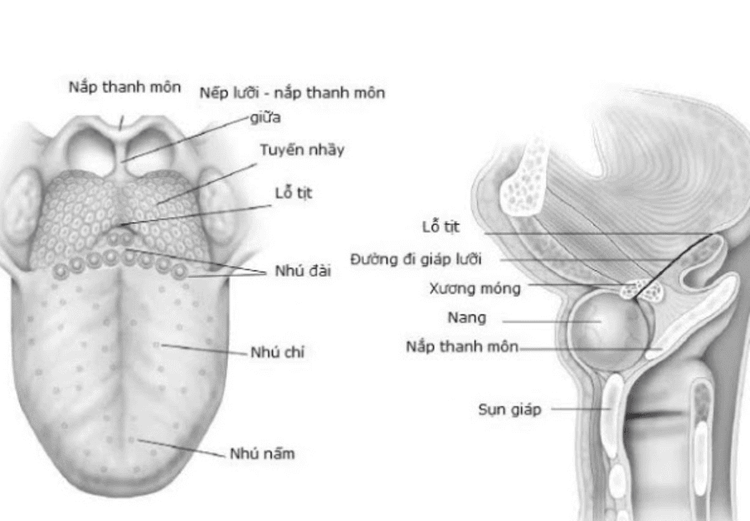
Vị trí U nang giáp móng
2. Clinical symptoms of thyroid cysts
Appears a tumor the size of a marble or larger than a kumquat in the skin of the anterior neck, corresponding to the position of the hyoid bone, attached to the hyoid bone, and the skin is normal. Tumor moves according to swallowing rhythm, when touched, it will feel tight but not painful; If not treated, the nail thyroid cyst will become super infected, swollen, hot, red, spontaneously bursting with pus mixed with mucus, creating a fistula with yellow fluid. The fistula sometimes closes on its own, after a few days it becomes swollen again, causing the skin around the fistula to become inflamed and thickened. Prolonged leakage time forms leaky pipes as strong as ropes; Rare: There is a cyst that changes in size, causing difficulty swallowing, large infected fistula. There are cases where the thyroid cyst is not located in the anterior neck region but on the anterior neck side or in the thyroid gland. There are cases where the thyroid cyst is ossified because the thyroid duct is stuck while the hyoid bone is developing; Aspiration with mucus.

Hình ảnh u nang giáp móng
3. Diagnosis of thyroid cysts
Use some imaging tests to evaluate, predict and diagnose thyroid cysts:
Thyroid ultrasound: Is one of the imaging tests used with high reliability to differentiate Thyroid cyst morphology compared with other tumors in the anterior neck region. The advantages of thyroid ultrasound are the identification of recurrent tumors that are not palpable after surgery, the normal thyroid gland, and the parenchymal pattern of the thyroid gland;
Contrast-enhanced X-ray of the cyst or fistula: To obtain additional imaging information regarding the relationship of the thyroid fistula cyst to the hyoid bone and adjacent anatomical structures. Patients are usually taken X-ray with contrast pump with upright position, slanted mouth;

Siêu âm tuyến giáp giúp chẩn đoán bệnh
Computed tomography (CT scan): Provides accurate information about the location, size, characteristics and relation to the surrounding structures of the cyst and cystic duct. In addition, CT scan is also of high value in diagnosing thyroid cysts appearing in the midline of the neck;
Magnetic Resonance Imaging (MRI): A method that provides the doctor with detailed information about the thyroid cyst and its relationship to surrounding structures.
4. Treatment of thyroid cysts
If not treated promptly, thyroid cyst disease can cause dangerous complications such as: infection of the thyroid cyst (causing hot, red, painful swelling with pus abscess), leakage of pus through the skin or into the throat, recurrence after surgery, causing neck deformity, hypothyroidism, cystic thyroid cancer,...
The only treatment for thyroid cysts is surgery (Sistrunk procedure). This is a surgical method along the midline of the neck, removing the entire thyroid cyst, the subhyoid duct, the hyoid bone body, the suprahyoid duct, and about 3mm of surrounding tongue tissue.
However, the treatment of thyroid cysts may not be as effective as desired due to factors such as: cystectomy alone, not accompanied by hyoidectomy (causing recurrence with a rate of up to 59 - 100%). And if the thyroid cyst is treated by aspiration, curettage, injection, incision, burning the fistula, the recurrence rate is up to 100%. Signs of recurrence of thyroid cysts can appear soon after the patient is hospitalized or after many years. On average, after about 4 months of treatment, the patient may have a recurrence of the thyroid cyst with manifestations such as inflammatory tissue mass, pseudocyst, and mucus leakage from the incision.
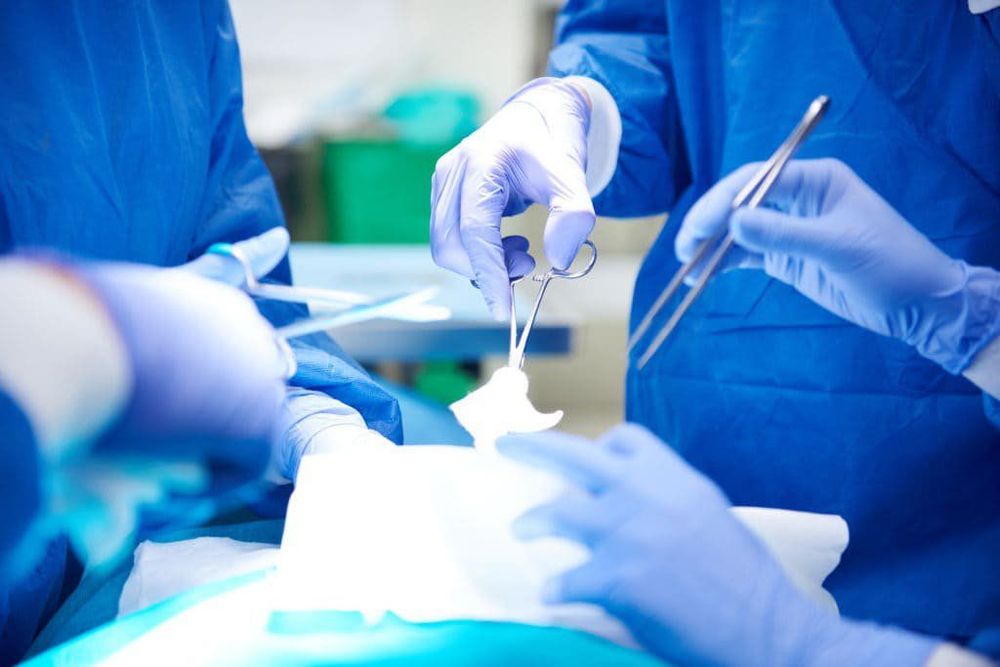
Điều trị u nang giáp móng bằng phẫu thuật
If not detected and treated early, thyroid cysts can cause many unpredictable complications. Therefore, when there are warning signs of this pathology, the patient should go to the doctor soon for an accurate diagnosis and appropriate and effective treatment.
For detailed medical advice, please come directly to Vinmec health system or book online HERE.
Recommended video:
Periodic health check at Vinmec: Protect yourself before it's too late!
MORE:
Common thyroid diseases and treatment Why are women more susceptible to thyroid disease than men? What is the purpose of thyroid ultrasound?




